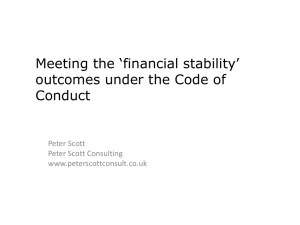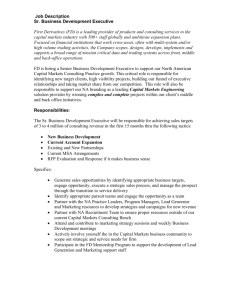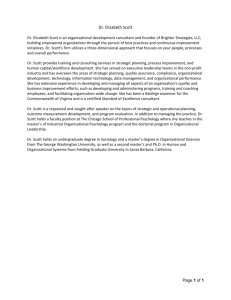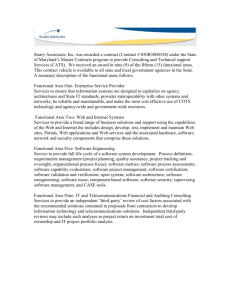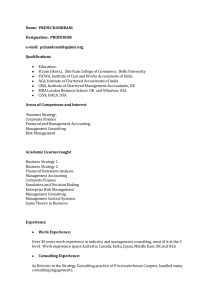How to achieve financial stability under OFR
advertisement
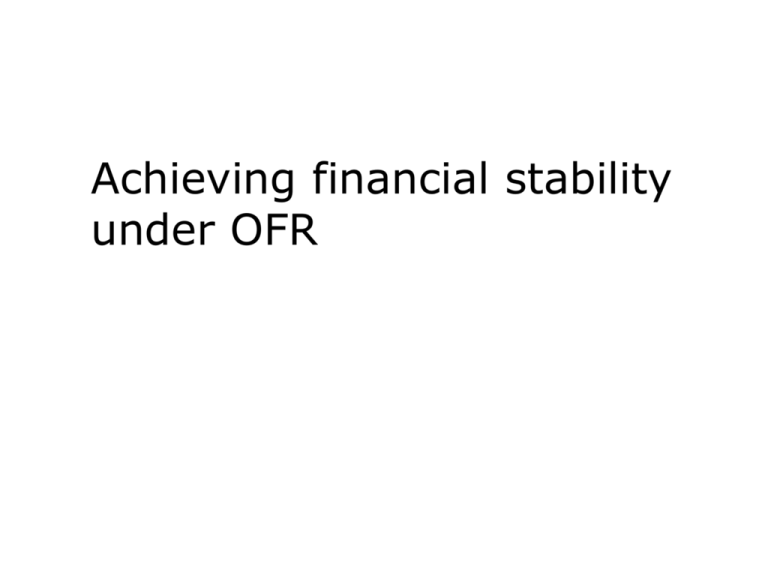
Achieving financial stability under OFR The scope of our course today 1. 2. 3. 4. Understanding the requirements of the Code Identifying your priority financial stability challenges Using financial measurement to manage financial stability Managing partner compliance and performance to achieve financial stability 5. Maximising your cash flow 6. Building profitability 7. Constructing your financial stability action plans 1. Understanding the requirements of the Code of Conduct regarding financial stability “stability” Firmly fixed or established; Not readily changing or fluctuating; Not easily destroyed or decomposed PETER SCOTT CONSULTING Outcome O (7.4) – Code of Conduct “you maintain systems and controls for monitoring the financial stability of your firm … and take steps to address issues identified” PETER SCOTT CONSULTING Acting in the following ways may tend to show that you have achieved these outcomes … IB (7.2) – controlling budgets, expenditure and cash flow IB (7.3) – identifying and monitoring financial …. risks including ….credit risks and exposure … PETER SCOTT CONSULTING Outcome O (10.3) “you must report to the SRA promptly any material changes to relevant information about you, including serious financial difficulty PETER SCOTT CONSULTING ‘material’? Guidance Notes to Rule 8 Authorisation Rules provide, in relation to a failure to comply: (x) In considering whether a failure is “material” and therefore reportable, the COLP or COFA, as appropriate, will need to take account of various factors, such as: • the detriment, or risk of detriment, to clients • the extent of any risk of loss of confidence in the firm or in the provision of legal services • the scale of the issue • the overall impact on the firm, its clients and third parties. Acting in the following ways may tend to show that you have achieved these outcomes … IB (10.2) – actively monitoring your financial stability and viability in order to identify and mitigate any risks to the public IB (10.3) – notifying the SRA promptly of any indicators of serious financial difficulty ….. IB (10.4) – notifying the SRA promptly when you become aware that your business may not be financially viable to continue trading as a going concern ….. PETER SCOTT CONSULTING Examples from the Indicative Behaviours which may mean you are not achieving the financial stability outcomes IB (10.3) – notifying the SRA promptly of any indicators of serious financial difficulty, such as inability to pay your professional indemnity insurance premium, or rent or salaries, or breach of bank covenants IB (10.4) – notifying the SRA promptly when you become aware that your business may not be financially viable to continue trading as a going concern, for example because of difficult trading conditions, poor cash flow, increasing overheads, loss of managers or employees and / or loss of sources of revenue. What should law firms be doing to make financial stability a PRIORITY? Identify who should be responsible for financial management Review financial measurement and reporting Financial education and training ‘Cash is king’ - take control of cash management Drive up revenue / control overheads Establish an ‘audit trail’ Adopt ‘zero tolerance’ and ‘partner accountability’ PETER SCOTT CONSULTING Who should be responsible for financial management? FD? Managing Partner? Both? Others? PETER SCOTT CONSULTING Establish an ‘audit trail’ “If you cannot demonstrate compliance we may take regulatory action” Measure what matters Report effectively Train your people Take advice if issues arise PETER SCOTT CONSULTING Take appropriate advice, act on it and document it NB – COLP’s and COFA’s responsibilities Outcome O (10.1) – you ensure you comply with all the reporting and notification requirements in the Handbook that apply to you Indicative behaviour IB (10.5) – notifying the SRA of any serious issues identified as a result of monitoring referred to in IB (10.1) and IB (10.2) and producing a plan for remedying issues that have been identified PETER SCOTT CONSULTING 2. Your financial stability challenges? Cash flow • To manage the bank overdraft? • To pay out last years profits? • Not to have to contribute more capital? • To pay out retiring partners? Profitability • To improve PEP by [ ]%? • To deal with partner underperformance? Others? 3. Using financial measurement to manage financial stability Measure what matters Measure what matters What is the purpose of financial measurement and reporting? PETER SCOTT CONSULTING To provide clear information to those running the business to enable them to: - Know what is happening / will happen in the business - Make decisions based on sound knowledge - Take effective action PETER SCOTT CONSULTING Financial measurement and reporting - creates KNOWLEDGE - manages RISKS PETER SCOTT CONSULTING Risk and Knowledge Management Risk Knowledge Management Management Financial measurement enables a business to manage performance PETER SCOTT CONSULTING If you cannot measure it, you cannot manage it. PETER SCOTT CONSULTING What do you measure? What do you report on? Is your financial measurement and reporting helping or preventing you achieving your objectives? PETER SCOTT CONSULTING Do you produce data or information? PETER SCOTT CONSULTING How do you use the financial information you produce? PETER SCOTT CONSULTING In a law firm what needs to be measured - and why? PETER SCOTT CONSULTING Examples of what matters -How can we measure the financial performance of each part of our firm? -How profitable / loss making are each of our clients? -Which parts of our firm generate good cash flow or soak up cash? PETER SCOTT CONSULTING Do you measure things which do not need to be measured in order to run you business - more effectively? - more profitably? - to generate more cash? PETER SCOTT CONSULTING Do you / your people use everything you measure / report? If not – why do you measure it / report it? PETER SCOTT CONSULTING Is there anything you should measure which you do not currently measure and report on? PETER SCOTT CONSULTING Your key performance indicators? PETER SCOTT CONSULTING Test your KPIs • • • • • Why do we produce this information? Does it tell us what we need to know about our business? What does it not tell us about our business? Do we ever use this information? If not then why do we produce it? PETER SCOTT CONSULTING Real time or historical information? For example - billings - input PETER SCOTT CONSULTING Your desired Outcomes? - Accelerating cash flow? Improving profitability? Building performance? Effective business development? Managing your risks and compliance? - Others? PETER SCOTT CONSULTING Hard copy or available on line? PETER SCOTT CONSULTING Frequency of reporting? PETER SCOTT CONSULTING NB - inaccurate reports destroy credibility PETER SCOTT CONSULTING Who needs what? How far do you disseminate financial information in your firm? - and for what purpose? PETER SCOTT CONSULTING Is it enough just to provide reports – or do you need to do more? The role of financial education in a law firm? PETER SCOTT CONSULTING Financial education and training “I don’t have a clue about the financial reports I receive” What do you want each partner / fee earner to financially manage? What do they need to know to be able to do this? PETER SCOTT CONSULTING Do your partners / other fee earners have financial knowledge gaps? Do they understand why you provide them with financial reports? Do they understand why you are asking them to take a certain action? PETER SCOTT CONSULTING Would a financial education programme for your firm help to achieve desired outcomes? NB – training is a good way to demonstrate compliance PETER SCOTT CONSULTING 4. Managing partner compliance and performance to achieve financial stability Get your partners into shape Financial management of a law firm is not so much about figures but all to do with managing people (particularly partners) Zero tolerance – partner accountability Are your partners prepared to be managed? The COLP and the COFA will not be able to effectively carry out their roles unless every partner accepts the principle of ‘accountability’ PETER SCOTT CONSULTING Your partners • Their behaviour • Their performance In the good times ….. • Why rock the boat? • Financial under-performance tolerated In an economic downturn ….. • Margins will be under pressure • Cash will be tighter • But will firms get to grips with financial under-performance? How can law firms address financial under performance issues in an economic downturn? Make the most of what you have Work smarter, not harder Do the basics better Slick Graphics Hyperlinks Cool Nice Pictures Your financial results GUI Stuff Your partners’ willingness to be managed One of the most sensitive issues for law firms • Highlights the tension between - need for modern business practice - traditional professional partnership BUT • If you deal effectively with the problem • The benefits can flow to bottom line Under performance = ? • Firms which under-perform will not be competitive • They will lose business • They will not attract and retain the best people A downward spiral Building higher performance • How much is financial underperformance costing? • What are firms going to do about it? Do you recognise any of these? “Heavyweight gorilla” “You can’t manage me. I’m a big biller!” “That’s a great idea …for the rest of you!” “Ahh…only five more years to go” Are you forever pushing at a closed door? Is your firm firing on all cylinders? Answer – Yes / No Are all your partners hungry? Answer – Yes / NO Do all your partners want to earn more? Answer – Yes / NO Do you have the ‘right partners’ on board to help you to achieve your goals? Answer – Yes / NO Are all your partners prepared to be managed? Answer – Yes / NO Are all your partners supportive of management and of each other? Answer – Yes / NO Are all your partners prepared to be accountable? Answer – Yes / NO Are there sanctions on a partner who refuses to comply? Answer – Yes / NO Do all your partners have sufficient financial discipline? Answer – Yes / NO Can you say your firm has no under performing partners? Answer – Yes / NO Do you know how much underperformance is costing you? Answer – Yes / NO Should all your equity partners really be equity partners? Answer – Yes / NO Are you prepared to face up to your issues and deal with them? Answer – Yes / NO Are you prepared to change every ‘NO’ to a ‘YES’? Answer - ? Are you prepared to provide the LEADERSHIP required for change? Accountability “We have no room for those who put their own personal agenda ahead of the interests of the clients or the office” David Maister’s “Predictive package” Embody accountability into your governance arrangements For example Undertakings to be compliant Agreement to do everything necessary to enable COLP and COFA to effectively carry out their roles Include indemnities to COLP and COFA Sanctions on those who do not comply PETER SCOTT CONSULTING Sanctions • • • • Necessary? Choice of sanctions? Do they work? Examples 5. Maximising your cash flow Who feels like this? Cash is king - take control of your cash management Instructions Work W.I.P billing Cash payment PETER SCOTT CONSULTING Debtors Cash management priorities taking instructions Managing the WIP Managing debtors Above all – managing partners! PETER SCOTT CONSULTING Working capital What is our firm’s working capital requirement? What is our debt / equity ratio? Are we able to consistently keep within our banking arrangements? Is a cash call on partners likely to be required shortly? Are we able to make distributions to partners from last year’s profits? Will we be able to pay January’s tax bill? Will we be able to repay capital to partners when they retire? PETER SCOTT CONSULTING Work smarter, not harder Do the basics better Put the squeeze on your business How to get to grips with financial and performance issues? Analysis is key With a view to….? • Diagnosing the causes of slow cash generation • Diagnosis will point to solutions Avoid Financial Information Overload KEEP IT SIMPLE Work in progress For each work type/group/partner • • • • • • • • Monthly WIP carried over last 12 months Current aged WIP Billing profile over last 12 months WIP at last three year ends Billing targets Terms of business Money on account Unbilled disbursements carried Work in progress Relatively easy to measure, monitor and value HOURS RATE BOOK WIP Adjust for realised rate Important KPI – should be calculated monthly Provisions Regular review and assessment Accurate WIP value Debtors For each work type/group/partner • • • • • • Average value of debtors carried Current aged debtors Cash collection profile Cash collection targets Terms of business Monies held on account of bills Debtors - actions • • • • Cash collection targets Review all unpaid bills over 30 days Use your credit control system Link cash collection to distributions of profit Lock Up Means value of work tied up in WIP and debtors -Plus disbursements Expressed as number of days -the time taken from doing work to getting paid Therefore calculated on production not billing -Billing lock up calculations distort this view Use to benchmark each area by what we would expect - Need to link this to funding How much is your ‘lock-up’? • “lock-up” (work done not paid for) = WIP + Unbilled disbursements + Unpaid bills (net of VAT) • “Excess lock-up?” = WIP over [ ] days? + Debtors over [ ] days? What do ‘leading edge’ firms do? (See notes) LOCK UP AND FUNDING • • • • If keeping pressure on lock up… …but running short of cash And profits are being maintained… …with significant growth being experienced • Then business is becoming under funded – Mix of capital, borrowing and credit taken • Risk of overtrading – Cannot fund growth in working capital – More acute if not on full earnings basis as will be looking at wrong measures and drawing wrong conclusions Lock-up For each work type/group/partner • Average lock-up as % of annual turnover • Aged lock-up • Value of one day’s/month’s lock-up Cash outgoings • • • • Monthly cash outlay Monthly cash receipts Monthly NET inflow/outflow Cash flow projections Finance group infrastructure • • • • Structure/headcount Credit controllers / revenue managers Credit control / cash management procedures Billing and collection policies • Systems How to use your finance team to maximise cash management Is your team performing? Financing of practice • Working capital requirement • • • • • • Partners’ fixed capital Current account balances Profit distribution policy Tax reserves Bank facilities Borrowing profile over last 12 months Cash Flow – finding solutions • • • • • • Produce a cash generation plan to focus on (in order of priority): How practice is to be financed Partner accountability - sticks/carrots Forward cash position goals Billing targets by person/group Collection targets by person/group Alignment of infrastructure to goals Cash management Partners’ capital should not be for supporting financial under performance Taking instructions/risk management – You are providing clients with credit, but you are not being paid to take credit risk – Terms of business – Money on account – Disbursements Benchmarks (= our new lock-up targets) • WIP – no more than [ ] average? • Debtors – no more than [ ] days average? • Lock-up – [ ] days maximum? How much working capital would a 30 day reduction in your lock-up release? Cash Management • Set minimum acceptable balance - eg £100k headroom to avoid o/d • Simplify cash flow - all figures to be gross (inc VAT etc) • Each month calculate cash needed to cover all outgoings for next 3 months (including partners’ drawings and distributions) • Calculate and broadcast weekly cash collection targets Cash Management (2) • Report weekly on cash collection • Plan billing targets to generate cash to pay major outgoings (November bills to pay January tax) • Recognise consequences of deviations +/- £25k per week = +/- £325 per quarter • Payments to partners to depend on cash collection Cash collection targets (1) Cash collection targets (2) Effect of £25k per week variance 500 400 300 200 100 0 -100 -200 -300 Novembe r De cember January Cash Colle ction +£25k per wee k Cash Colle ction on Target Cash Colle ction -£25k per we ek February 6. Building profitability – practical steps to make a real difference Margins are being squeezed Drive up revenue – control overheads Flabby law firms are failing To drive up revenue To drive down costs PETER SCOTT CONSULTING Maximising profitability Work smarter, not harder Efficiency • Efficiency = Utilisation x Recovery • Utilisation = chargeable hours recorded as a % of standard working hours (220 days x 7 hours = 1540) • Recovery = % of recorded chargeable time billed How to get to grips with profitability issues? Analysis is key Scope of analysis? • Where the firm is making or losing money – To determine areas for investment • Benchmarking performance – Internally and externally by department • Trend analysis • Recommendations on KPIs Avoid Financial Information Overload KEEP IT SIMPLE Profitability factors • Work types • Clients • Leverage • Pricing • Matter related hours • Realisation rate • Major overheads The work type / client type focus is crucial to profitability Profitability factors • Work types • Clients • Leverage • Pricing • Matter related hours • Realisation rate • Major overheads Work types • Each work type as a % of overall turnover • Net profit per equity partner for each work type/group Clients • Total numbers of clients in each of last three years • % of turnover represented by top 10% / 20% of clients (by billing value) • Net profit derived from each of above categories as a % of total • Ditto for bottom 10% / 20% The competitive moves High Perceived Added Value X Ave Suicide Zone Low Low Ave Perceived cost High Profitability factors • Work types • Clients • Leverage • Pricing • Matter related hours • Realisation rate • Major overheads Leverage For each work type /group • Net profit per equity partner • Number of fee earners (including partners) • Experience of each fee earner (including partners) • Delegation Leverage will differ from group to group Will depend on: • work type / client type mix • How the group ‘adds value’ to its clients Each group to consider how it should be leveraged for maximum profitability Leverage – each group should be broadening the base Equity partners Other fee earners Instead of doing this Equity partners Other fee earners Delegation is key to profitability • Match the work to the appropriate level of expertise / cost • Sell at the right price! Each group to consider how it should delegate more to increase its margin Leverage and delegation involve teamworking Why are teams important? Teams provide • Support • Ability to delegate • Continuity of service delivery • Sense of purpose /Esprit de corps • Accountability / peer pressure Each group to consider how to build their teams An integrated strategy Leverage Delegation Focus Adding value Profitability factors • Work types • Clients • Leverage • Pricing • Matter related hours • Realisation rate • Major overheads Pricing For each person/work type/group/client • • • • • • Headline rates Local comparables/competitiveness Recovered rates Latest rate changes Value billing arrangements Fixed fee work Profitability factors • Work types • Clients • Leverage • Pricing • Matter related hours • Realisation rate • Major overheads Chargeable hours • • • • • • • Methods of recording time Units of recorded time Frequency of reporting Available time Recorded chargeable hours by person/group/firm Targets set Sector norms Profitability factors • Work types • Clients • Leverage • Pricing • Matter related hours • Realisation rate • Major overheads Realisation Rate • W/O of WIP by each person/group/firm at selling price • Every 1% of realisation rate = ? • W/O of debtors by each of above groups • Disbursements written-off Profitability factors • Work types • Clients • Leverage • Pricing • Matter related hours • Realisation rate • Major overheads Major Overheads • Salary costs as % of total overheads • Salary costs by group/work type • Premises/Equipment costs as % of total overheads • Professional indemnity costs as % of total overheads • ZBB applied? People costs Gross profit as a key performance indicator? Measures of profitability Bills Delivered Billing X Other income & w/os X WIP movement __ Income X Costs of employment Gross profit (%) Direct Overheads Contribution Indirect overheads Operating profit (%) Add back notionals Profit before tax for EPs Full Earnings X X X X X X (%) X X X X X X (%) X X X X X X X X Control overheads – how ‘lean’ are you ? Is this overhead really necessary for the efficient and profitable operation of our firm or could we do without it / use it less?” We know we must have this overhead, but how can we reduce the cost of providing it?” PETER SCOTT CONSULTING Profitability – finding solutions • • • • • Net profit per partner is priority – focus on: Nature of business/clients Improving leverage Pricing Increasing chargeable hours Improving recovery rate • Reducing waste Profitability – finding solutions Focus on : building the top line . Build the ‘top line’ – make the most of what you already have price work (for profit); manage work to a price to achieve the required margin; fully record matter-related time; and maximise the realisation (recovery) of work in progress on billing. How much more profit would you make if you did each of those just a little better? PETER SCOTT CONSULTING Who is never guilty of the ‘Triple Whammies’? The TRIPLE WHAMMIES – • Under pricing • Under recording • Under realisation Pricing If… • You have 30 fee earners • Each averaging 1000 hours p.a • Increase rates by £10 p.h and fully realise How much more revenue will you generate in a full year? £10 p.h rate increase across the board will produce… £300K additional revenue RECORDING MATTER RELATED TIME - to make fee earners more productive ‘Why should I fully and honestly record all my matter related time?’ Do you know your matter related hours target? Are you on target? Time How have you spent your time today? Time How much of that time have you recorded as matter related time? Time How much of your matter related time today have you not recorded? Why not? What is ‘matter related time’? Why is matter related time not recorded? I was told not to record time on the matter! ‘Because I am not worth it!’ ‘The job will not justify all my time!’ ‘I cannot be seen to have big write – offs’ I don’t have enough time to record! I don’t have enough time to time record! I can’t remember what I did during the day! Time is not relevant to our part of the firm’s business Recording matter related time is relevant to EVERY part of a firm’s business Why is recording matter related time so important? Time is an important management tool Time is about a firm’s financial health 1. How to estimate a fee? ‘How much will this cost me?’ Time is just one factor to be taken into account in arriving at the right price for the job If you under record time you are pre-judging the decision as to what is the right price for the job. Whose decision? If you consistently under record time on your work it will not be possible to safely quote a price for a job in the future because you will not know how much that job will cost you to do 2. Are we working profitably? How do we know we are profitable if we do not know how much our work is costing the firm to do? 3. How to budget for revenue? Number of fee earners X Their agreed target chargeable hours X Their hourly rates 4. Are we ‘on budget’? Fully recording matter related time enables us to compare performance with budget 5. Fully recording your time will help you to achieve your billing targets more easily and quickly. How? An extra 30 minutes recorded per day? 30 minutes X 220 working days pa = 110 hours 110 hours at £200 ph = £22,000 6. Management of workloads in groups – - who is busy? - who is not so busy? How easy is it for you to record time? Do you need more training? Realisation rate • Every 1% on your realisation rate = ? Write off policy • How much do you write off each year? • Introduce a write off policy eg: - all time to be w/o more than £500 or 5% of recorded time whichever is the higher has to be approved by managing partner Benchmarks (= our new targets) Realise 95%+ average of wip - your current average? If… you halve the amount you write off, by how much will your annual profits increase? By reducing … • Under-pricing • Under-recording • Under- realisation how much more profit would you make? 2012 / 13? WE ARE GOING TO earn PEP of £[ ]K Is this realistic? - to be tested Do we all want that? 7. Your financial stability action plan? • Cash management • Profitability What are you going to take away from today and do something about? Any questions?


